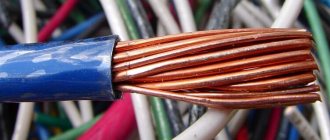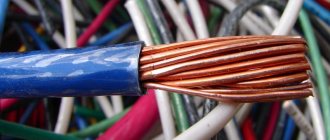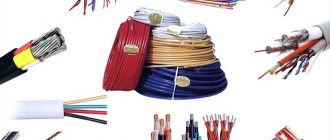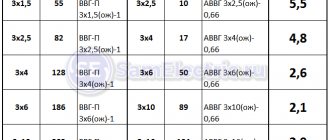Electricity has become an integral part of modern life. To ensure comfortable living conditions, both in the apartment and in the office, all household appliances require electricity to operate. Electrical wiring is a complex that includes various types of wires, terminal blocks and other elements. The article will discuss what types of electrical wiring there are and what their distinctive features are.
Variety of species
Electrical cords and their classification
Below we will look at the cables used in electrical wiring. The classification of electrical wiring is as follows:
- Aluminum;
- Copper.
Nowadays, those types of wiring with copper cores inside are in great demand. This is explained by the resistance of the metal, which is several times less compared to aluminum. Thus, having the same cross-section, more current passes through the copper cords, and accordingly, it produces more power. Copper electrical cables can also last longer.
Aluminum cable
As for aluminum, this type of wiring is cheaper, so before the advent of modern examples it was installed in many places. Even now it continues to be in demand, mainly due to its low cost.
There are also types of electrical wiring:
- Single-core. They do not provide for flexibility and are rigid, so they are good for simple hidden wiring. They are characterized by good reliability and durability and do not require frequent replacement;
- Stranded. Good softness allows them to be bent without loss of quality. Due to their plasticity, they are widely used in electrical cords for various household appliances. With the help of such cables, open electrical wiring is installed. There is a special requirement for their installation - the presence of double insulation. In a word, each core is insulated separately, after which the cables are covered with a common sheath.
Note! It is better not to use simple twisting to connect wires of different metals. If such a need is nevertheless required, it is recommended to use wiring terminals. Otherwise, the galvanic couple will work poorly: it will start to heat up, lose contact, or oxidize.
Types of electrical wiring differ in location:
- Internal. Using it, they equip residential, industrial and warehouse premises with different environmental conditions;
- Outdoor. With the help of such a connection, electric current is transmitted in open space, where there is a place for various precipitation, temperature changes, solar radiation and other factors.
Methods for laying electrical cables are:
- Hidden. For installation, various niches and voids in building structures are used. Many facing materials are suitable for sealing;
- Open. Cables “stretch” along the surfaces of walls and structures or are suspended between.
Types of cables
There are different modifications of cables. Their classification includes groups that differ in purpose and structure.
To transmit information
The following cables are used to transmit information:
- RG-6, RG-59, RG-58, RK75 - they are called “antennas”. The conductors are monolithic or bundled; between the insulation layers there is a shielding braid. They transmit high frequency signals and low currents.
- Computer twisted pair - consists of 4.8 pairs of intertwined conductors. Depending on the number of pairs there are CAT1, CAT2 and CAT5e. This solution provides better signal reception and transmission. There is a tearing thread inside, it helps to easily cut the outer insulation. These cables differ in the screen used; it can be made of foil or in the form of a copper braid.
Power
Using power electrical cables, external and internal wiring is laid; they come in the following types:
- VVG - allows you to transmit current up to 1000 V and 50 Hz. Core cross-section from 1.5-240 mm². The wire is reliably protected by internal and external insulation. There are the following modifications of this cable: AVVG - aluminum core; VVGng - non-flammable insulation; VVGp - flat, etc.
- NYM is the European analogue of the domestic VVG. It is characterized by higher reliability and quality. It has 2-3 copper stranded conductors, can withstand up to 660 V, and bends well (4 diameters). It is used for external and internal networks, it is afraid of solar radiation.
- KG - all insulation is made of rubber, so the cable is highly flexible. Rated for 600 V and 400 Hz. It is used to connect welding machines, heaters and other powerful equipment.
- VBBSHv - consists of 15 copper cores (single or multi-wire), with a cross-section of 1.52-240 mm². PVC insulation; the same material fills the voids between the cores. The metal plate armor makes the cable particularly durable, and it can operate at 1000 V.
Features of external open electrical wiring
Plastic electrical wiring boxes: sizes and types
For these electrical installation works, overhead power lines are used, which are wires and supports made of wood or reinforced concrete. Based on the rules for operating electrical installations, the following standards have been developed:
- If a bare wire is used, then there must be a distance of at least 2.75 meters from it to the nearest horizontal surface;
- If the wiring is laid above the road surface, the recommended distance from the surface is 6 meters;
- The overhead line should not be laid along the roof of the structure (exception is the power supply);
- Bare wires on a line operating under 220V voltage must be located at a distance from each other of more than 15 centimeters;
- It is important to maintain a distance of at least 1.5 meters between wires and balconies (windows).
If you need to connect a separate building to a power line, as a rule, aluminum wires are used. Some time ago, non-insulated cables were popular, but now insulated wiring is more preferred.
Wiring in a wooden house
Interesting. A metal such as aluminum can easily withstand the difficult climatic conditions found in various regions of Russia. Standard aluminum wire is guaranteed to last over 45 years.
To select the optimal cross-section, the electricity consumption of all household appliances is calculated, the starting currents of the motors and possible voltage drops are taken into account. An insulated cable or SIP wire is used for entry into the building. If you have a choice between a cable made of copper or aluminum, it is better to give preference to the former, since these types of classic wiring have 30% more electrical conductivity.
Features of external hidden electrical wiring
Cable channel for electrical wiring
It is important to understand that urban conditions are cramped enough to use open wiring. Therefore, it is relevant mainly for street lighting. Each power supply network is hidden in underground communications. To connect individual buildings, special distribution devices (substations) are built, for which cable routes are required.
Cables are laid in concrete gutters or metal pipes (reliable insulation from underground moisture is required). Artificial rubber and polymer materials are used to produce insulation.
Interesting. As a rule, these are cables of the AVRG brand (power cable made of aluminum with rubber insulation in a PVC sheath).
Types of speaker cables
To connect acoustic devices so that they produce good sound, special cables are used:
- TPC - copper wire, belongs to the cheapest category. Copper for its production is obtained by rough cleaning.
- OFC - oxygen-free copper is used here. This ensures good cable conductivity.
- PCOCC - high quality pure copper is used to create it, which ensures good characteristics of the finished product.
Features of internal wiring
It can be open or hidden. This is a simple and convenient installation method, so it is often used. Wires can be mounted in various ways when choosing open wiring:
- In cable channels (ducts);
- In corrugated pipes;
- For insulators;
- On the staples.
Wires for electrical wiring
If special cable channels are selected, then the installation of electrical cables is carried out in special boxes made of non-flammable plastic. The box itself is a U-shaped structure made of plastic, for fastening which self-tapping screws are used. The electrical wiring is first placed in the box, after which the latter is closed with a lid with 2 locks.
Interesting. To form complex electrical circuits, modern production offers a wide range of various accessories. It is popular to use tees, clamps, plugs, junction boxes, special inserts, and so on.
To achieve an attractive look, modern cable channels are available in various colors and shades. For example, in a wooden house, a brown channel looks good, harmonizing with the surrounding interior. Others prefer to use various decorative elements, for example, baseboards, under which the wires are placed.
Wall mounting
Cable channels are in demand due to the following advantages:
- They are easy to install and dismantle;
- They have a pleasant appearance. You can always choose the right color;
- If necessary, they can be easily opened if the wire needs to be repaired or replaced;
- Affordable price.
Important! They also have a drawback - installation is only possible on a flat surface and after complete shrinkage of the structure.
The types and types of modern electrical wiring are different, as is their installation. Thus, corrugated pipes are often used for laying cables. However, this is relevant if installation is carried out on an uneven surface, or bends are required. The corrugated pipes themselves come in various diameters, and non-flammable material is used for their production, which allows several cables to be placed in them. The clamps for this product are a metal tie or plastic clips. A corrugated pipe has a minus: it cannot be laid in a straight line, as over time it will sag, thereby losing its aesthetic appearance.
At the moment, those residents who prefer the style of antiquity use porcelain roller insulators for wiring. This type of wiring was relevant in ancient times, when there were no other methods. The procedure looks like this: an insulator is mounted on a wall or surface, on top of which wires are installed. It is necessary to use exclusively double-insulated copper wires.
Interesting. In wooden houses, plastic boxes or metal brackets are often used for laying cables. This economical method quickly creates open electrical wiring, and you can do it yourself, without the help of an electrician.
Types of optical cables
They are designed for organizing external or internal lighting. May be called glowing wires, because After connecting to the network, their insulation glows. This is achieved due to the transparent outer shell, under which there are LEDs. If the wire is damaged, it can be quickly found, because the diodes will stop working there.
The coating can be luminescent; it glows when voltage is applied. Such products resemble neon tubes, but unlike them they are highly flexible. They are used to create inscriptions, when designing and decorating various objects.
Rules for working with wires
Protective equipment during work
Before connecting the wire, you should measure the required length by cutting and stripping the insulation from the edge of the cable. To do this kind of work, various tools are used. We are talking about long-nose pliers (round nose pliers) and wire cutters. When purchasing such tools, you need to ensure that their handles are insulated. Using regular pliers it is convenient to handle large cables. Round-nosed pliers that have wire cutters on the ends are ideal if you want to roll the bare end into a ring. The cutters also allow you to cut part of the wire, even if it is in a hard-to-reach place.
However, the most versatile and useful tool is an insulation stripper. It consists of openings for pressing ends, cutters and calibrated holes that allow you to trim and remove the insulation. This tool allows you to do many manipulations with cables.
To protect yourself and others when performing electrical work, you should adhere to certain rules:
- Use only serviceable equipment, reliable power tools, carriers and extension cords;
- It is recommended to turn off the power supply before starting work. You should use RCDs or automatic machines. Someone may accidentally turn on the voltage on the site; to prevent such a situation, you should first hang a warning sign;
- Use testers and indicator screwdrivers as insurance;
- Check the quality of insulation on working tools;
- Try not to carry out installation work alone - help can always come in handy.
If the electrical wiring is laid under the ceiling, then it is better not to use chairs or tables. For this purpose, only a platform is required. There must be a fire extinguisher in the room where the work is being carried out, since sparking wires cannot be doused with water.
Recommendations from experts
Above we looked at what types of electrical wiring there are, now let’s get acquainted with a number of subtleties on how to work with them correctly:
- The work is carried out as a whole, and not in parts, otherwise you end up with a lot of twists and connections, which over time can become outdated and deteriorate. As a result, you will have to damage the wall to get to the wiring;
- First, we determine the location of sockets, lighting fixtures, household appliances, boxes and plugs. Next, a general electrical wiring diagram is drawn up. It is necessary to take into account that the refrigerator and washing machine require a separate line, as particularly powerful equipment;
- It is necessary to calculate the network power. To do this, add up the total power of devices installed on the same line (should not exceed 5 kW);
- During work, use only high-quality material, otherwise the wiring cannot be called reliable;
- The network should be changed during repairs before finishing the room. The wiring is laid from the switchboard to the apartment. It can be carried along the walls in any position, and then secured in corrugated pipes or plastic boxes.
Note! Since aluminum connecting wires have a significant service life, the wiring is kept as simple as possible to make it easier to deal with if necessary.
There is a huge selection of cables and wires, where each type is used in one situation or another. Before starting any electrical work, you need to familiarize yourself with what the wiring is and what methods are used to install it. Do not neglect safety rules, as electricity is dangerous if handled carelessly.











